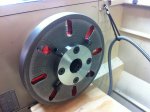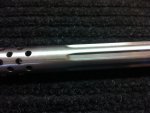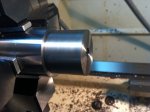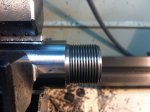i have been looking into buying a lathe. All the ones i look at are 3 phase, found out they make single phase lathes. does anyboby use or prefer a 3 phase or a single phase? Reason im asking is most the single phase ones i seen dont have the fluid nozzles for continuos fluid during the chambering process. Is it really needed, or prefered?
Join the Hide community
Get access to live stream, lessons, the post exchange, and chat with other snipers.
Register
Download Gravity Ballistics
Get help to accurately calculate and scope your sniper rifle using real shooting data.

Install the app
How to install the app on iOS
Follow along with the video below to see how to install our site as a web app on your home screen.
Note: This feature may not be available in some browsers.
You are using an out of date browser. It may not display this or other websites correctly.
You should upgrade or use an alternative browser.
You should upgrade or use an alternative browser.
Gunsmithing lathes
- Thread starter shortman308055
- Start date
There are several guys around here that do excellent work without coolant or pressurized cutting fluid.
The 3 phase machines can also be run off of a phase converter. I'm running a static converter, but most seem to favor the rotary ones.
The 3 phase machines can also be run off of a phase converter. I'm running a static converter, but most seem to favor the rotary ones.
Is it better cutting in terms of thread cutting and such to have a 3 phase? Im in the electrical industry and am a lineman for duke energy, and it is costly if you live on a single phase line and want it converted to a 2 phase or 3 phase, depending on which voltage bank of transformers is in need to supply the correct voltage (120/240 volts) (120/208 volts) (277/480 volts) if i can get the same end results with a single phase machine it will be much simplier....and cheaper
I've heard that single-phase motors have inherent harmonics associated with them that can translate into vibrations and ultimately chatter. 3-phase motors, so the story goes, don't suffer from this. I don't know if any of this is true, but I prefer a 3-phase machine even if I have to use a phase converter. As an added bonus, you get precise speed control and a lot of other neat tricks (like electric braking) with an electronic phase converter.
3ph motors are generally better quality, you'll find a lot of guys having issues with single phase motors especially Chinese ones.
I believe 3ph have better braking even without a vfd. Also if I'm not mistaken if you run 3ph on true 3ph power you can instant reverse the spindle, if you do that on a single or split it will just continue on in the same direction.
As a vfd user with 3ph lathe, I highly recommend. Lots of variables you can set, and awesome braking.
Galaxy S3 on tapatalk
I believe 3ph have better braking even without a vfd. Also if I'm not mistaken if you run 3ph on true 3ph power you can instant reverse the spindle, if you do that on a single or split it will just continue on in the same direction.
As a vfd user with 3ph lathe, I highly recommend. Lots of variables you can set, and awesome braking.
Galaxy S3 on tapatalk
A coolant system can be installed on pretty much any lathe quite easily. Most non commercial places are not going to have 3phase power such as home workshops. Using a phase converter cuts the actual horsepower of the motor by approximately 1/3 from everything I have read, also most warranties on equipment are void if using a phase converter. A single phase motor works fine when wired correctly with proper voltage especially if it is simply a hobby type workshop and not a commercial high production operation.
I am no electrician but as it was explained to me 3 phase has a smoother power curve. AC electricity cycles at 60 Hz, meaning 60 pulses per second. With standard 220 you have two hot legs so power is "on" 120 times per second. With 3 phase it is "on" 180 times per second so there are more "peaks" in the power pulse.
Think of an oscilloscope, a single 110V AC pulse will show 60 peaks and valleys on the scope. Now add another 110 leg and you have 60 additional peaks and valleys although they are not timed the same. Now add a 3rd 110V leg and again you have 60 more peaks and valleys again, not timed the same.
You have less time between peaks so you have a smoother power impulse which can be felt on a machine and it can show in the finished product.
Hope that makes sense, like I said I am no sparky.
Whether or not a phase converter reduces the available Horsepower depends on the converter. A "static" converter only serves as a starter for a 3 phase circuit so yes, you lose a third because you don't have an actual 3rd hot leg running to your motor.
A rotary converter provides a true 3rd leg of 110V AC so you do not lose any power to the motor.
Can't make a comment on VFD's as I have no experience with one.
Think of an oscilloscope, a single 110V AC pulse will show 60 peaks and valleys on the scope. Now add another 110 leg and you have 60 additional peaks and valleys although they are not timed the same. Now add a 3rd 110V leg and again you have 60 more peaks and valleys again, not timed the same.
You have less time between peaks so you have a smoother power impulse which can be felt on a machine and it can show in the finished product.
Hope that makes sense, like I said I am no sparky.
Whether or not a phase converter reduces the available Horsepower depends on the converter. A "static" converter only serves as a starter for a 3 phase circuit so yes, you lose a third because you don't have an actual 3rd hot leg running to your motor.
A rotary converter provides a true 3rd leg of 110V AC so you do not lose any power to the motor.
Can't make a comment on VFD's as I have no experience with one.
Last edited:
The one cuts better than the other theory is BS. You are opening up a big can of worms with this debate. It's a major Ford versus Chevy thing. If you ask an old die hard American Iron machinist he'll tell you to go three phase and mortgage your house to pay for a US machine and wire your house for three phase etc. For the "non production" guy that might chamber on 50 rifles in the next 5 years, your single phase smaller machine is just fine. If you are shopping for a machine based on whether or not it has a coolant pump or not, that's probably not what you should be looking at. Three phase motors are more efficient, have more starting torque and typically more robust. But we are more than likely talking about machines in the 2-4hp range here. You are not going to be able to tell the difference on your light bill! Single phase motors have starting capacitors that overcome any lower starting torques noticed. If a cap goes bad, replace it for $10. If a phase converter or VFD goes bad.....well lets just say it's cost you A Lot more than $10. Hell, just replace the single phase motor and that'll still be cheaper than buying all the crap to run a 3ph motor in your garage. All that being said, If I was putting another machine in my shop and I already had three phase power, I would buy a three phase machine. Which is what I just did, I found a nice old Clausing drill press and love it. I love all the old American Iron, but they are not necessary for a hobbyist to produce very fine work. Attached are pictures of some various bits I've done on a Grizzly 1ph lathe that came nicely tooled out right from the factory. The faceplate spider is something I copied from bald eagle but was done with a piece of 316SS and that's the surface finish "as cut". Same with the muzzle brake except for the "after" picture with it polished. A single phase machine, if it's not some worn out unit, will cut nice work for a long time if taken care of. Is that lathe perfect? No. Little things like the paint and sharp edges on some of the castings etc. remind you it came from china. But structurally, it's a great machine. It's got an adequate spindle through hole, 2hp, an outboard spider(so I wouldn't have to build another) and all the rests and chucks etc. Be sure to look at the spindle bore size and if it has room to add an outboard spider, on anything you are looking for. They are a lot more important than continuous coolant while chambering. I've done some continuous fluid/flushing while reaming and I could ream a chamber a lot faster that way but has since gone back to the manual , oil, cut, pull reamer, rinse, re-oil, cut, pull reamer etc etc method. Be thinking about containing the fluid and the mess it makes on your machine when you use a pressure fluid system. Imagine putting your finger into the hole on the end of a garden hose and then pulling it out. How does the fluid spray when you uncork it? Get the picture? If I was trying to ream 50 chambers next week, I would set it back up and "get 'er done". But I'm not, so I use the other method. Works for me.
Attachments
Simply use a VFD(variable frequency drive) to run a 3 phase lathe.
I am running a three phase motor 220/440 on 110 volts using a variable frequency drive for the last four years with no issues.
You can probably find a three phase lathe cheaper and pick up vfd and have a decent set up
Shortman,
Don't be afraid of a three phase machine. Having both an almost new Shop Fox Gunsmiths lathe (single phase) and and an older Clausing three phase run with a VFD there is no comparison in the versatility of the VFD. Except when threading the drive belt on the Clausing stays on the fourth step on the pulley and the spindle speed adjusted with the VFD. The Shop Fox is going to be changed over soon. It is a gear head and lacks in the speed selection department. Dale My mill is also VFD driven with no problems for three years.
Don't be afraid of a three phase machine. Having both an almost new Shop Fox Gunsmiths lathe (single phase) and and an older Clausing three phase run with a VFD there is no comparison in the versatility of the VFD. Except when threading the drive belt on the Clausing stays on the fourth step on the pulley and the spindle speed adjusted with the VFD. The Shop Fox is going to be changed over soon. It is a gear head and lacks in the speed selection department. Dale My mill is also VFD driven with no problems for three years.
not afraid of 3 phase, i hold 23,000 volts in my hands on a daily basis, (its not fun on a foggy morning) just want to make sure if i buy a house on a single phase line, that i will be able to get me a lathe to build rifles. been looking at the grizzlys single phase, its only in the 3,000 to 4,000 dollar range which coinsides with my budget i want to spend. im only going to be doin my own work but i wanted to get an outlook for future reference thanks to all you guys for the input.
I love my Grizzly single phase, it will do anything you will ever want to do and also comes with features you dont get on other lathes. If you decide to purchase the Grizzly gunsmithing lathe I dont think you will be disappointed at all. Where I work we have a machine shop that builds aerospace hardware and they have some of the nicest machines on the planet and the machinists are always amazed at the stuff I can do with my little chinese made Grizzly. I believe these machines are the best bang for your buck, hands down. I will say this though, I wish Grizzly had just a little better tech support with a little more knowledge on the stuff they sell. But if you have questions there are enough people on the web with them that you can find almost any info you need.
One challenge with vfd conversions on machines over about 10 years old is the insulation that is used on the motor windings is not ideal for vfd use. I'm not saying it won't work or last, you just may have some other issues. I have all old iron myself, a 40's vintage monarch 16x48, a Bridgeport series 2 j head....
What Duke won't make you a deal on a 3 phase service????? You think you would be able to! I used to be a lineman, now inside power plant electrician. The co I worked for wanted $4000 just for the service drop, and the minimum bill was going to be about $100 a month. So phase converter/ vfd it is!
On the single phase vs three phase cut quality, as long as you know your machine there should be no difference. One of the machinist at work (machinist for over 40 years) has the same opinion. Single phase motors have lower dynamic torque which allows for greater speed changes during loading, but that takes it back to the operator knowing there machine.
Sent from my XT1080 using Tapatalk
What Duke won't make you a deal on a 3 phase service????? You think you would be able to! I used to be a lineman, now inside power plant electrician. The co I worked for wanted $4000 just for the service drop, and the minimum bill was going to be about $100 a month. So phase converter/ vfd it is!
On the single phase vs three phase cut quality, as long as you know your machine there should be no difference. One of the machinist at work (machinist for over 40 years) has the same opinion. Single phase motors have lower dynamic torque which allows for greater speed changes during loading, but that takes it back to the operator knowing there machine.
Sent from my XT1080 using Tapatalk
I got hired by a company that was being sued for $100k per week for holding up an aircraft development because they could not drive a 3 phase permanent magnet starter motor to start a jet engine. I filled up their luggage compartment with my rube goldberg temporary 3 phase drive design and we started the engines. That was a 24 hour a day job that telling about is like telling war stories.
Things are even MORE mickey mouse at my house where I have a phase a matic mounted on my 3 phase mill and the label is gone, so I can't even tell which model it is. But it works fine. I had a Clausing 5914 3 phase lathe [Boeing surplus] and I ran it off the mill phase a matic, and that worked fine. Now I have single phase Chinese lathe, Precision Mathews, and it really gets the gunsmithing done.
It looks like this... but then again, who knows whats in there?
Static Phase Converters | Travers.com
Things are even MORE mickey mouse at my house where I have a phase a matic mounted on my 3 phase mill and the label is gone, so I can't even tell which model it is. But it works fine. I had a Clausing 5914 3 phase lathe [Boeing surplus] and I ran it off the mill phase a matic, and that worked fine. Now I have single phase Chinese lathe, Precision Mathews, and it really gets the gunsmithing done.
It looks like this... but then again, who knows whats in there?
Static Phase Converters | Travers.com
Last edited:
None of the included oil systems are suitable for pressure flushing while chambering. Those pumps are plenty to keep your tooling cool but don't have the pressure required to flush with. To flush you will need an external system capable of 60-100 psi. Even at 100 psi my doesn't spray all over because it only hit that high pressure when the reamer is actually cutting. As soon as I start to back out the restriction is opened and it just flows out nicely.
A 3 phase machine is usually an industrial machine. The single phase is generally a hobby machine. What kind of results are you after?
I run two machines off my 15 horse American Rotary Digital 3 phase converter 15HP Rotary Phase Converter | Phase Converters | American Rotary
Power is not a problem.
A 3 phase machine is usually an industrial machine. The single phase is generally a hobby machine. What kind of results are you after?
I run two machines off my 15 horse American Rotary Digital 3 phase converter 15HP Rotary Phase Converter | Phase Converters | American Rotary
Power is not a problem.
Similar threads
- Replies
- 5
- Views
- 531
Precision Rifle Gear
Chronograph Testing: Gun Mount vs. Static
- Replies
- 7
- Views
- 795





